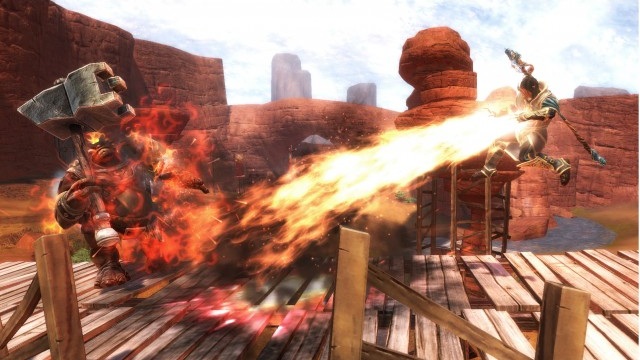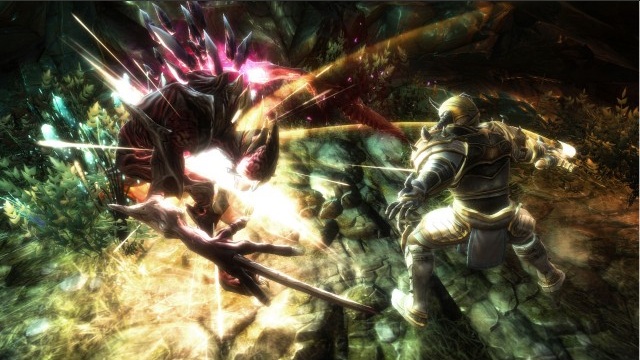Fantastical fantasies.
For a critic, being unimpressed is easy. Lying about it is even easier. With all the games we're responsible for covering and all the iterations of games, be they sequels or generic genre fodder, Kingdoms of Amalur: Reckoning is one title that can reveal how much we take for granted in the industry. At first, it looks like a common high-fantasy, hack-'n'-slah RPG. After two hours, it becomes a hybrid of many other high-fantasy, hack-'n'-slash RPGs. After four, it made me grip my controller and wish Electronic Arts didn't force me out of the event venue and onto the cold, gray streets of San Francisco.
Actually, I first saw Kingdoms of Amalur out of the corner of my eye at E3, housed in yet another white, nondescript booth box immediately across from another white booth box that had the words “Mass Effect 3”. It was almost as if Kingdoms of Amalur was meant to slip under my radar. (My ninja sense tingled.) But how could it really, when fantasy author R.A. Salvatore created the universe and lore, Spawn creator Todd McFarlane drew the artwork, and Ken Rolston applied his expertise from his experience as lead designer for both Morrowind and Oblivion. Oh, are you listening now?
Perhaps it's best to describe Reckoning in terms of other games, the first of which is Fable with a touch of Torchlight. Not only is Kingdoms of Amalur: Reckoning a third-person combat-oriented RPG, but its open-world environments are lush and colorful: neon green columns supporting the halls of a mine shaft, a waterfall splashing into a lake with several large koi, a Black Cohosh plant wilting away after being harvested for reagents. The world is expansive, with an incredible amount of detail and locations, and you can teleport to any place you've discovered for easy access.
If that doesn't lure you in, the combat system will grab your attention. Fans of Fable will recognize the standard trio of melee, ranged, and magic, but there's more depth than simply hacking an enemy with a sharp metal stick. Getting through battles unscathed, or at least alive, is about as challenging as Dungeon Siege III or God of War, depending of course on whether the game is set on Casual, Normal, or Hard. There's nothing inherently wrong with sprinting at an enemy and swinging your longsword, but using your full arsenal is a much better route—firing a charged shot from your bow, parrying a bandit's sword with your shield, timing your sword swings to launch an enemy into the air, and electrocuting a troll with lightning from your fingertips.

If you really want to stick it to a boss, you expend all your fate energy, gathered by successfully hitting enemies, by entering the titular Reckoning mode. The world darkens, your character's eyes begin to glow ice-blue, and all your foes are at your mercy as you alter their fate with the mark of death. After you bring them to their knees, you can then impale one of them with a particularly nasty lightning rod, as if it were made from the bolts of Zeus, and gain up to a 100% experience boost for disposing all of them in one fell swoop.
Certainly, the best part of leveling up is gaining additional skills, and Reckoning rewards you by complementing your playstyle, whatever that happens to be. Skills are split into three distinct but familiar trees: Might for proficiency in swords and hammers as well as increased battle awareness and durability; Finesse for proficieny in daggers, bows, and stealthy sneak attacks; and Sorcery for mana efficiency, elemental spells, and proficiency with staves and sceptres.
How you choose to distribute your points will determine what equipment you have access to as well as which Destiny best fits your strategy. Each Destiny rewards you with bonuses, like increased melee damage and elemental resistance, depending on whether you focus on Might, Finesse, or Sorcery, a hybrid of two, or a jack of all trades. But don't worry if you've made a mistake; for a fee, a Fateweaver can unbind your destiny and let you redistribute all of your skill points. (Don't you wish Skyrim had a Fateweaver?)

The particular reason why you're able to gather fate energy as well as control your destiny is explained vaguely within the first few cut-scenes. No matter how you customize your character's race, gender, or appearance, your character has been seemingly raised from the dead after fighting against the normally kind and fair Fae, who essentially play as the pointy-eared elves. After what seems to be a coup, Gadflow takes control of the Fae and orders them to conquer the world of mortalkind, and while mortalkind has been able to hold them back for ten years, their numbers have ultimately dwindled. All of this has been forseen, as the threads of fate bind the world tightly, but after being somehow resurrected, you soon discover that your fate is unknown and thus you alone have the power to turn the tide.
If that weren't enough, just like in The Elder Scrolls, you can find alchemic ingredients and smithing materials to craft new potions and equipment. You can also outfit socketed weapons and armor with gems, in part using shards looted from enemies and found in treasure chests, most of which are either locked or protected by a ward. Lockpicking works as it does in Bethesda games as well, while dispelling wards opens a circular timing mini-game. Either way, it gets you a chest full of items that are collected much like treasures in Dragon Age: Origins. (See, I told you it was everything in one.)
Though Kingdoms of Amalur: Reckoning might look like a generic fantasy RPG, it has the making of a solid, all-around fantasy RPG that combines the strengths of its genre brethren into one ultimate mixture. It releases February 7, 2012 for Xbox 360, PS3, and PC.







